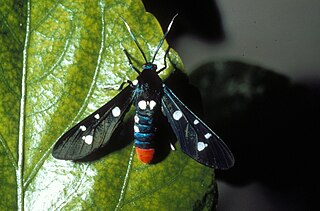
Syntomoides imaon, the handmaiden moth, is a moth of subfamily Arctiinae, subtribe Ctenuchina. The systematics of the subfamily has been revised. It was described by Pieter Cramer in 1780. It is well distributed in Sikkim, Khasi hills and throughout India Kerala, Sri Lanka, Myanmar, Bangladesh and Hong Kong, Viet Nam.

Autochloris is a genus of moths in the subfamily Arctiinae.
Neidalia is a genus of moths in the family Erebidae. The genus was erected by George Hampson in 1901.

Syntomeida is a genus of tiger moths in the family Erebidae.

Darapsa choerilus, the azalea sphinx, is a moth of the family Sphingidae first described by Pieter Cramer in 1779. It is found in the United States and southern Canada east of the Rocky Mountains.

Cyligramma latona, the cream-striped owl, is a moth of the family Noctuidae. The species was first described by Pieter Cramer in 1775.

Ercheia cyllaria is a species of moth of the family Erebidae first described by Pieter Cramer in 1779. It is found in the Indian subregion, Sri Lanka, Taiwan, Japan, Indochina, Thailand, Peninsular Malaysia, Sumatra, Borneo, Seram and the Kai Islands.

Trigonodes hyppasia, the triangles or semi-looper, is a moth in the family Erebidae. The species was first described by Pieter Cramer in 1779. It is largely cosmopolitan, found throughout Borneo, Fiji, India, Nepal, Sri Lanka, São Tomé and Príncipe, Taiwan, Zimbabwe, northern Australia, and almost all African countries.

Trigonodes cephise is a moth of the family Noctuidae first described by Pieter Cramer in 1779. It is found from the Indo-Australian tropics to northern Australia, the Caroline Islands, Samoa and New Caledonia, Nias and other islands on the south-west of Sumatra.

Pergesa is a monotypic moth genus in the family Sphingidae first described by Francis Walker in 1856. Its only species, Pergesa acteus, the green pergesa hawkmoth, was described by Pieter Cramer in 1779.

Darapsa is a genus of moths in the family Sphingidae first described by Francis Walker in 1856.

Callionima pan is a species of moth in the family Sphingidae. It was originally described by Pieter Cramer in 1779.

Dinia eagrus, the scarlet-tipped wasp mimic moth, is a moth of the family Erebidae. The species was first described by Pieter Cramer in 1779.

Ernassa cruenta is a moth of the family Erebidae first described by Walter Rothschild in 1909. It is found in French Guiana, Ecuador, Peru and the Brazilian state of Amazonas.

Ernassa justina is a moth of the family Erebidae first described by Caspar Stoll in 1782. It is found in French Guiana and Suriname.

Neidalia bifasciata is a moth of the family Erebidae first described by Pieter Cramer in 1779. It is found in Suriname.
Amata polidamon is a moth of the family Erebidae. It was described by Pieter Cramer in 1779. It is found in South Africa.

Rhodogastria amasis, the tri-coloured tiger moth, is a moth in the family Erebidae. It was described by Pieter Cramer in 1779. It is found in Lesotho, Mozambique, South Africa and Zimbabwe.

Cydosia nobilitella, the curve-lined cydosia moth or regal cydosia moth, is a moth of the family Noctuidae. The species was first described by Pieter Cramer in 1779. It is found from southern Florida south to Argentina. It is also found on the Antilles.
Callizygaena auratus is a moth in the Zygaenidae family. It was described by Pieter Cramer in 1779 from Sri Lanka. One subspecies is recognized, C. a. nivimaculaFelder & Felder, 1874.

















